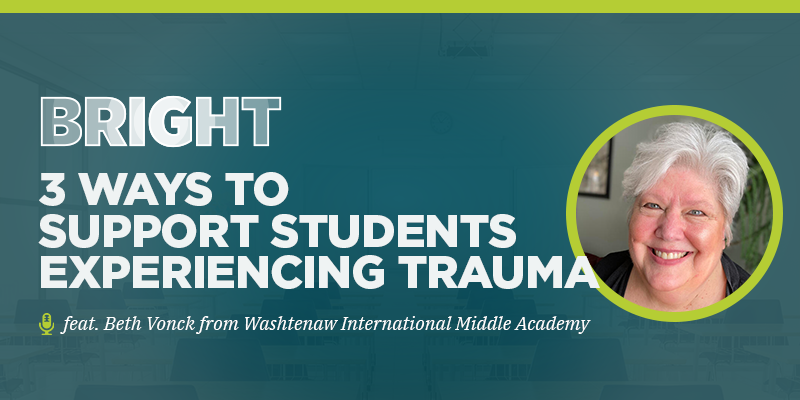Or listen on Apple, Spotify, Google, or another platform. Alternatively, you can read along with the transcript.
When students sit down at their desks, you can’t often tell what traumas they’ve experienced that may be affecting their ability to learn that day.
In this episode of BRIGHT, I chat with Beth Vonck, a language and literature teacher for Washtenaw International High School and Middle Academy, who was honored as a 2021-22 regional teacher of the year.
In this episode of the BRIGHT podcast, Beth and I explore:
- Why trauma-informed instruction is so critical to student success,
- Examples of what this looks like in practice in Beth’s classroom, and
- Three guidelines for supporting students experiencing trauma.
A quick note on the content of this episode: As we discuss trauma experienced by young people, there are some brief mentions of sexual abuse, violence, mental illness, and suicide. Listener discretion is advised.
Here’s a sneak peek at our conversation:
You can listen to my conversation with Beth using the audio player above or by subscribing to the BRIGHT podcast in your app-of-choice (find us on Apple, Spotify, Google, and more) or by reading along with the transcript.
Of course, we understand that educators are busier than ever. If you don’t have time to listen to Beth’s full episode (which offers the fuller effect of her wisdom, energy, and examples), you can still benefit from a glimpse at her top three tips below.
3 ways to support students experiencing trauma
#1. Practice making students feel seen
This may seem like a simple suggestion, but Beth greets every student as they come through her door.
Given all the pressures teachers are under, it can certainly be easy to get busy or underestimate the power of welcoming each child into your classroom.
With over 30 students in her class, this initial greeting is one place that Beth can build a personal relationship with each student and intervene if something is wrong.
“Names are powerful,” Beth says.“Sometimes, this might be the only time an adult says a child’s name in a whole day.”
During our interview, Beth shared an incident from three days prior, where a student broke into tears upon being greeted. She got the young girl a chair and gave her a few minutes to decompress while her classmates filtered into the classroom.
Upon talking to the student, it became clear that she was struggling with her mental health. As a result of that conversation, Beth was able to enlist help from her principal and get the student the help she needed.
Most days, Beth clarifies, the conversations are a bit more lighthearted. She compliments students on a new haircut or learns about a pet goldfish they got over the weekend.
By greeting students at the door, she has a chance to ensure her students feel seen and cared for.
#2. Avoid power struggles
Beth’s next suggestion is to avoid getting into power struggles with students.
For example, when a student is disruptive, it may be tempting to say, “I see what you’re doing, and I need it stopped.”
But too often, this leads to students becoming defensive. The result is that both you and the student are set up for failure.
Beth explains that the more excited a student’s emotions become, the more critical it is for their teacher to be calm to help them co-regulate.
To avoid power struggles, she does her best to reframe conversations about student behavior with key questions, such as, “What do you need from me?” and “How are you going to do that?”
Consider the following scenario: A student isn’t working on an assignment when they’re supposed to be. You could approach the student and say, “You need to get started on your assignment,” but this would immediately put you in an adversarial relationship.
Instead, Beth would say, “What do you need from me to get started on this assignment?”
“Well, I guess I just need to do it,” the student might respond.
To this, she could reply gently, “Oh, okay. Well, how are you going to do that?”
Beth speaks with a calm, compassionate tone. You can tell when she offers these examples that she brings genuine curiosity into her relationships with students rather than judgment.
By intentionally avoiding power struggles, she creates space for her students to pause and reflect on what they need to succeed.
#3. Assume good intentions
Beth says that students don’t seek to get on their teachers’ nerves or give them a hard time. Even though it may feel intentional sometimes, there is always a root cause behind every behavior.
It isn’t personal.
Students experiencing high trauma are constantly scanning their environment, looking for triggers. A student could be triggered by something as simple as you speaking in way that reminds them of their mother. In this situation, the way they respond to you is not at all personal, even if it may feel that way.
When assuming good intent in student behavior, you must first acknowledge that there is a root cause, whether or not you (or even the student) know what it is.
The hard thing to accept is that you may not be able to fix the root cause of the student’s behavior, but you can at least reframe your own perspective to help them as best you can.
“You can’t always be that person to everybody at all times,” Beth admits. “But knowing it’s not about me, so I’m not going to take this personally, that’s the big thing. You’ve got to assume those good intentions. Because a lot of times kids really do like you, and they really do want to please you.”
By assuming good intentions, she sees beyond her student’s current behavior and gently helps them move forward.
My favorite quotes from this episode
“If we are not addressing the whole child, then we aren’t addressing the child at all.”
“Our job as teachers is trying to figure out how to teach a child who has kept a part of themselves hidden. To do that, we have to be able to understand what is impacting the child beyond our doors. That’s what trauma is all about. Many times, the things students can’t share — or are reluctant to share — are in the forefront of their brains when they come into our classrooms. I didn’t have breakfast. I didn’t have dinner last night. Is somebody going to be home when I get there? My birthday is coming up. Am I going to have a birthday this year? Is my little sister going to get picked up from the bus? All of these kinds of questions are what our kids are thinking about. We’re not. We’re standing in front of the class, saying, ‘Okay, everybody, let’s look at this sentence. Can you see a noun in this sentence? How about a verb? Let’s talk about imagery.’ Well, they could care less because the image in their head is not the same image that we have.”
“What would make a straight, white female think I was hurting children just by asking about their family? It didn’t occur to me. Because even though I wasn’t raised in a traditional house, I was a traditional teacher. Now, I think differently. One of the things we do with students is ‘I used to think, but now I think.’ So, you know, ‘Please don’t hold against me what I used to think, because I’m not there now.’ With trauma-informed education, we can all be in a different spot and forgive each other and ourselves for not knowing better. Like Maya Angelou says, ‘When you know better, do better.’ Now, I know better, and I’m certainly doing better.”
“When a child walks through the door, the parent has sent us the very best that they have. They walk through the door, and they look like every other child. When they’re standing there, you cannot tell that they have a particular trauma. It’s when they start doing an assignment or how they respond to you or others. That’s where you begin to see the differences.”
“The first time I walked into the classroom, I knew I was home. I knew that this is what I was meant to do.”
Related resources
- Read: Reaching and teaching children who hurt: Strategies for your classroom by Dr. Susan Craig
- Read: Cultivating genius: An equity framework for culturally and historically responsive literacy by Dr. Gholdy E. Muhammad
- Learn and earn: Trauma-Informed Schools: A Whole School Approach (6 SCECHs)
- Learn and earn: Social Emotional Learning: Trauma-Informed Support (6 SCECHs)
- Learn and earn: Anti-Racist Trauma-Informed Practice in Pre K-12 Education (8 SCECHs)

